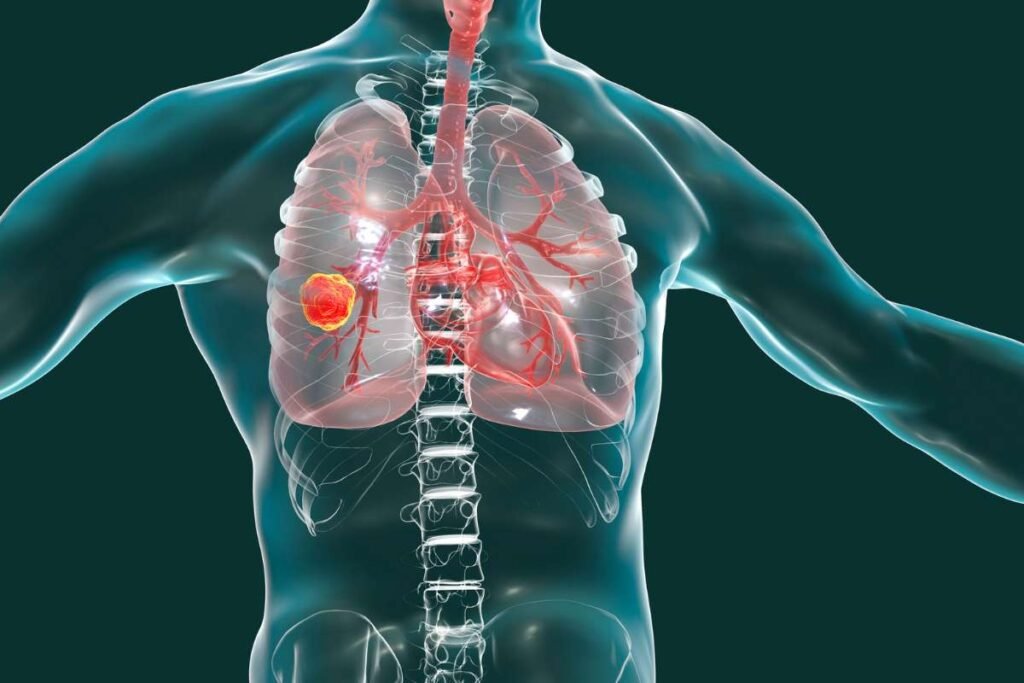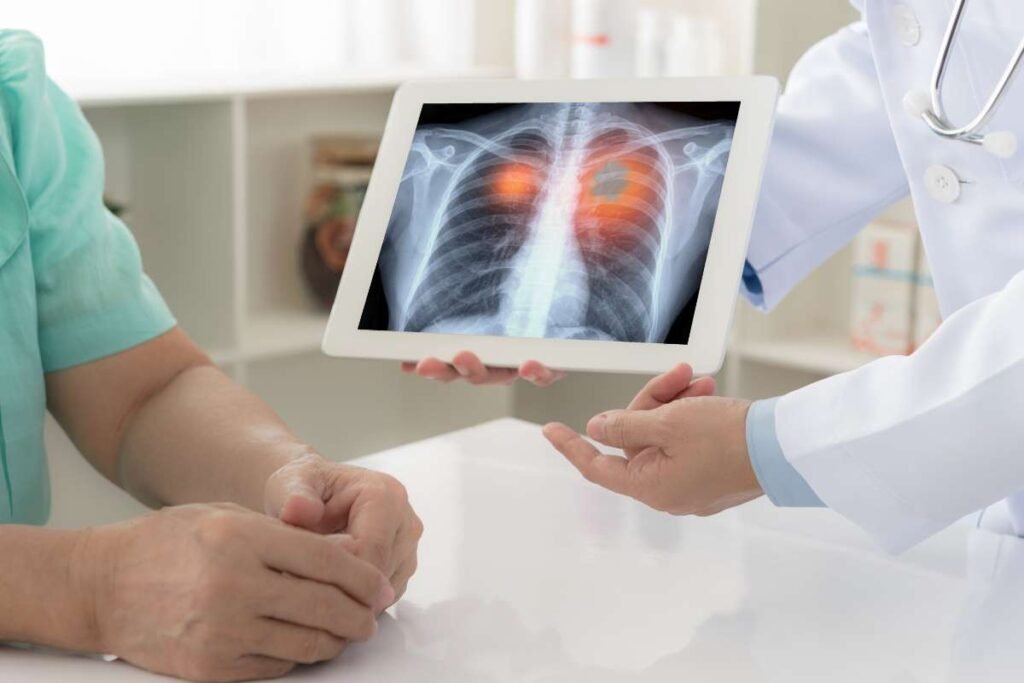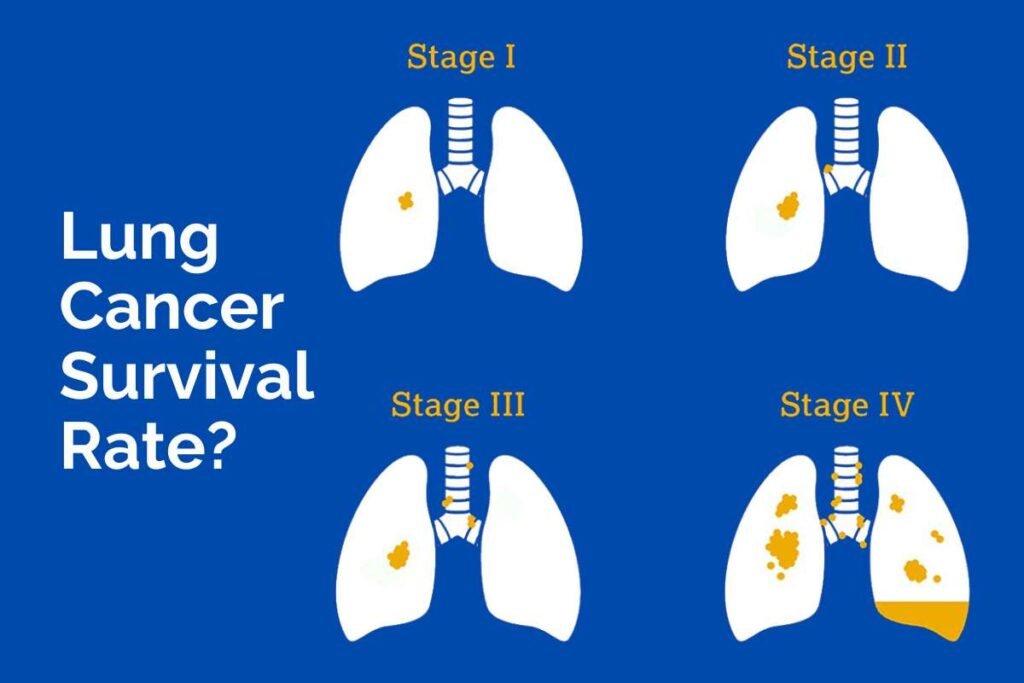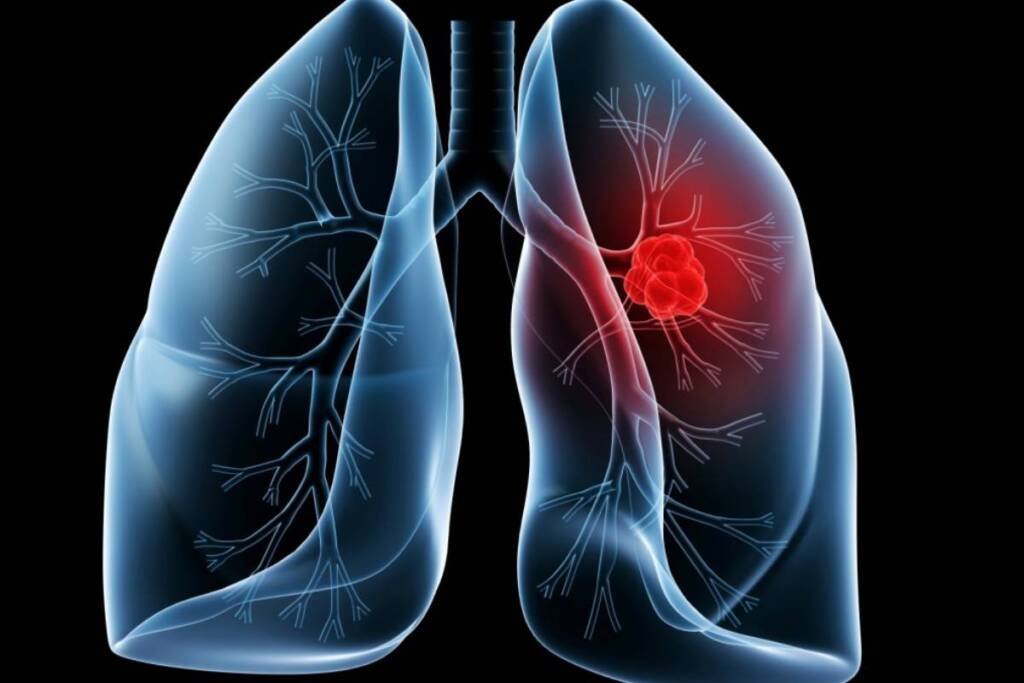A Comprehensive Guide to Lung Cancer Stage 3 Survival Rate and Treatment Options
This blog will reveal all about lung cancer stage 3 survival rate. Lung cancer is one of the most common and deadly types of cancer worldwide. According to the World Health Organization, lung cancer caused 1.8 million deaths in 2020, accounting for 18% of all cancer deaths. Lung cancer is often diagnosed at an advanced stage, which affects the prognosis and treatment options. In this blog post, we will discuss what lung cancer stage 3 means, the symptoms, how it is diagnosed and treated, and the lung cancer stage 3 survival rate.
What is Lung Cancer Stage 3?

Lung cancer is classified into stages based on the size and location of the tumor, the involvement of nearby lymph nodes, and the spread to other organs. The stages range from 0 to 4, with 0 being the earliest and 4 being the most advanced. Stage 3 lung cancer is when cancer has spread beyond the lung where it started but not to distant parts of the body. There may be chest pain, coughing, wheezing, shortness of breath, and other symptoms.
There are two main types of lung cancer: non-small cell lung cancer (NSCLC) and small cell lung cancer (SCLC). NSCLC accounts for about 80 to 85% of all lung cancers and tends to grow and spread more slowly than SCLC. SCLC accounts for 10 to 15% of all lung cancers and tends to grow and spread more quickly than NSCLC.
Stage 3 lung cancer is further divided into subcategories depending on the type and extent of the disease. For NSCLC, stage 3 is subdivided into 3A, 3B, and 3C. For SCLC, stage 3 is either limited or extensive.
Lung Cancer Stage 3A NSCLC
Stage 3A NSCLC is when cancer has spread to the lymph nodes on the same side of the chest as the primary lung tumor but not to other body parts. The tumor may also have invaded nearby structures such as the main bronchus, the chest wall, the diaphragm, or the membrane around the heart.
Lung Cancer Stage 3B NSCLC
Stage 3B NSCLC is when cancer has spread to the lymph nodes above the collarbone or the nodes on the opposite side of the chest from the primary lung tumor. The tumor may also have invaded other structures in the chest, such as the heart blood vessels, the trachea, the esophagus, or the nerve that controls the voice box.
Lung Cancer Stage 3C NSCLC
Stage 3C NSCLC is when two or more separate tumor nodules in the same lobe of a lung have spread to nearby lymph nodes. The tumor may also have invaded all or part of the chest wall or its inner lining, the phrenic nerve that controls breathing, or the sac membranes surrounding the heart.
Lung Cancer Limited SCLC
Limited SCLC is when cancer affects one lung and the lymph nodes on the same body side. The tumor may also have invaded nearby structures in the chest.
Lung Cancer Extensive SCLC
Extensive SCLC is when the primary tumor has spread further in the chest or to other organs such as the liver, bones, or brain.
What are the Symptoms of Lung Cancer Stage 3?

Lung cancer stage 3 may cause various symptoms depending on where and how much cancer has spread. Some of these symptoms include:
- A persistent cough that does not go away or gets worse
- Coughing up blood or rust-colored sputum
- Chest pain that worsens with breathing, coughing, or laughing
- Shortness of breath or difficulty breathing
- Wheezing or hoarseness
- Weight loss or loss of appetite
- Fatigue or weakness
- Recurrent infections such as bronchitis or pneumonia
- Swelling of the face, neck, arms, or veins
- Difficulty swallowing or pain in swallowing
- Bone pain or fractures
Some of these symptoms may also be caused by other conditions such as asthma, allergies, or infections. Therefore, seeing a doctor if you experience any unusual or persistent symptoms that do not improve with time or treatment is important.
How is Lung Cancer Stage 3 Diagnosed?
To diagnose lung cancer stage 3, a doctor will perform a physical examination and ask about your medical history and symptoms. The doctor will also order tests to confirm the diagnosis and determine how far the cancer has spread. These tests may include:
- Chest X-ray: A chest X-ray can show abnormal shadows or masses in the lungs that may indicate lung cancer.
- CT scan: A CT scan can provide more detailed images of the lungs and other organs in the chest and abdomen. It can also show the size and location of the tumor and the lymph nodes that may be affected by the cancer.
- PET scan: A PET scan can show how active the cells are in different body parts. It can help detect cancer cells that may have spread to other organs or tissues.
- MRI scan: An MRI scan can provide detailed brain and spinal cord images. It can help detect cancer cells that may have spread to the nervous system.
- Biopsy: A biopsy is a procedure that involves taking a small sample of tissue from the tumor or the lymph nodes for microscopic examination. It can confirm lung cancer diagnosis and determine its type and subtype.
- Molecular testing: Molecular testing is a laboratory test that analyzes the cancer cells’ genes, proteins, or other molecules. It can help identify specific mutations or changes affecting how the cancer behaves and responds to treatment.
How is Lung Cancer Stage 3 Treated?
The treatment of lung cancer stage 3 depends on several factors, such as the type and subtype of lung cancer, the location and size of the tumor, the involvement of lymph nodes and other organs, the overall health and preferences of the patient, and the availability of clinical trials. The main goals of treatment are to control the growth and spread of cancer, relieve symptoms, and improve quality of life.
The main types of treatment for lung cancer stage 3 are:
- Surgery: Surgery is an operation that involves removing part or all of the affected lung and nearby lymph nodes. Surgery may be an option for some patients with stage 3A NSCLC with a single tumor that can be completely removed. Surgery may also be combined with other treatments, such as chemotherapy or radiation therapy, before or after the operation.
- Chemotherapy: Chemotherapy is a treatment that uses drugs to kill or stop the growth of cancer cells. Chemotherapy may be given alone or combined with other treatments, such as surgery or radiation therapy. Chemotherapy may be given intravenously (through a vein) or orally (by mouth).
- Radiation therapy: Radiation therapy is a treatment that uses high-energy rays or particles to damage or destroy cancer cells. Radiation therapy may be given alone or combined with other treatments, such as surgery or chemotherapy. Radiation therapy may be given externally (from a machine outside the body) or internally (from a radioactive source inside).
- Immunotherapy: Immunotherapy is a treatment that uses substances that stimulate or enhance the immune system’s ability to fight cancer. Immunotherapy may be given alone or combined with other treatments, such as chemotherapy or radiation therapy. Immunotherapy may be given intravenously (through a vein) or subcutaneously (under the skin).
- Targeted therapy: Targeted therapy is a type of treatment that uses drugs that target specific molecules or pathways that are involved in the growth and survival of cancer cells. Targeted therapy may be given alone or combined with other treatments, such as chemotherapy or immunotherapy. Targeted therapy may be given orally (by mouth) or intravenously (through a vein).
The choice of treatment for lung cancer stage 3 may vary depending on the availability and eligibility of clinical trials. Clinical trials are research studies that test new drugs, devices, or procedures for treating lung cancer. Clinical trials may offer access to new or experimental treatments not yet approved by the Food and Drug Administration (FDA). However, clinical trials also have potential risks and uncertainties, such as side effects, costs, and outcomes. Therefore, it is important to discuss with your doctor about the benefits and risks of participating in a clinical trial.
What is the Lung Cancer Stage 3 Survival Rate?

The lung cancer stage 3 survival rate estimates how many people with the same type and stage of lung cancer are still alive after a certain period of time, usually five years, after diagnosis. The lung cancer stage 3 survival rate is based on statistics from large groups of people and does not reflect each patient’s individual situation.
The lung cancer stage 3 survival rate depends on several factors, such as the type and subtype of lung cancer, the extent of disease spread, the response to treatment, and the overall health and age of the patient.
According to data from SEER (Surveillance, Epidemiology, and End Results), a program of the National Cancer Institute, based on people diagnosed with NSCLC between 2010 and 2016:
- The five-year lung cancer stage 3 survival rate for stage 3A NSCLC is about 36%.
- The five-year lung cancer stage 3 survival rate for stage 3B NSCLC is about 26%.
- The five-year lung cancer stage 3 survival rate for stage 3C NSCLC is about 13%.
According to data from SEER based on people diagnosed with SCLC between 2010 and 2016:
- The five-year lung cancer stage 3 survival rate for limited SCLC is about 31%.
- The five-year lung cancer stage 3 survival rate for extensive SCLC is about 6%.
It is important to note that these lung cancer stage 3 survival rates are based on historical data and may not reflect lung cancer patients’ current or future outcomes. Advances in diagnosis and treatment may improve the lung cancer stage 3 survival rate over time. Moreover, these lung cancer stage 3 survival rates are averages and do not account for individual factors that may affect each patient’s prognosis. Therefore, talking to your doctor about your specific situation and expectations is advisable.
How to Cope with Lung Cancer Stage 3?
Being diagnosed with lung cancer stage 3 can be overwhelming and challenging. You may experience various physical, emotional, and practical issues that affect your quality of life. However, there are ways to cope with lung cancer stage 3 and find support and hope. Some of these include:
- Learning as much as you can about your type and stage of lung cancer, the treatment options, the possible side effects, and the lung cancer stage 3 survival rate. This can help you make informed decisions and prepare for what to expect.
- Seeking professional help from a doctor, nurse, social worker, counselor, or therapist who can provide medical care, emotional support, guidance, and resources. They can also help you manage symptoms, cope with stress, deal with financial or legal issues, and access palliative or hospice care if needed.
- Joining a support group or online community of people who have lung cancer or are caregivers of lung cancer patients. This can help you share your feelings, experiences, and tips with others who understand what you are going through. You can also learn from their stories and insights and find encouragement and inspiration.
- Seeking help from your family, friends, neighbors, or volunteers who can offer practical assistance, emotional support, companionship, or respite care. They can also help you with daily tasks such as cooking, cleaning, shopping, driving, or caring for children or pets.
- Practicing healthy habits include eating well, staying hydrated, getting enough rest, exercising moderately, quitting smoking, avoiding alcohol and drugs, and managing pain and other symptoms. These can help you maintain your physical and mental well-being and cope with the effects of treatment.
- Finding ways to relax and enjoy life, such as listening to music, reading a book, watching a movie, meditating, praying, doing yoga, gardening, painting, or pursuing a hobby. These can help you reduce stress, express yourself, and find meaning and joy in life.
Conclusion
Lung cancer stage 3 is a serious condition that requires prompt diagnosis and treatment. The prognosis and treatment options depend on various factors such as the type and subtype of lung cancer, the extent of disease spread, the response to treatment, and the overall health and age of the patient. The lung cancer stage 3 survival rate is low but not hopeless. There are ways to cope with lung cancer stage 3 and find support and hope from professional help, support groups, family and friends, healthy habits, and enjoyable activities.
If you have been diagnosed with lung cancer stage 3 or know someone who has, we hope this blog post has provided you with some useful information and resources. Remember that you are not alone in this journey; there is always hope for a better tomorrow.
Also Read: Multiple Myeloma: What You Need To Know About This Rare Blood Cancer
FAQ’s
What is lung cancer stage 3, and how is it diagnosed?
Lung cancer stage 3 is a type of lung cancer that has spread to nearby lymph nodes or other parts of the chest but not to distant organs. A physical exam, imaging tests, blood tests, and a lung tissue or lymph node biopsy diagnose lung cancer stage 3.
What are the main types of lung cancer stage 3 treatment, and how do they work?
The main types of lung cancer stage 3 treatment are surgery, radiation therapy, chemotherapy, immunotherapy, and targeted therapy. Surgery involves removing the tumor and some surrounding tissue. Radiation therapy uses high-energy rays or particles to kill cancer cells or shrink tumors. Chemotherapy uses drugs to kill cancer cells or stop them from dividing. Immunotherapy boosts the body’s natural defenses to fight cancer. Targeted therapy uses drugs that target specific genes or proteins involved in lung cancer growth or survival.
What are the benefits and risks of each type of lung cancer stage 3 treatment?
The benefits and risks of each type of lung cancer stage 3 treatment depend on various factors, such as the subtype and location of cancer, the patient’s age and overall health, preferences, and goals, and the potential side effects. Some general benefits and risks are:
– Surgery can offer a chance of curing localized or early-stage lung cancer, but it can also cause complications such as bleeding, infection, pain, breathing problems, and damage to nearby organs.
– Radiation therapy can shrink tumors and relieve symptoms, but it can also damage healthy tissue and cause side effects such as skin irritation, fatigue, cough, shortness of breath, chest pain, esophagitis, and an increased risk of secondary cancers.
– Chemotherapy can kill or slow down the growth of advanced or metastatic lung cancer, but it can also cause side effects such as nausea, vomiting, hair loss, mouth sores, low blood cell counts, increased risk of infection and bleeding, kidney damage, nerve damage, and hearing loss.
– Immunotherapy can stimulate the immune system to attack cancer cells, but it can also cause side effects such as flu-like symptoms, rash, itching, fatigue, fever, chills, nausea, diarrhea, low blood pressure, and allergic reactions.
– Targeted therapy can block specific pathways that drive lung cancer growth or survival, but it can also cause side effects such as fatigue, nausea, diarrhea, rash, liver damage, high blood pressure, bleeding, and blood clots.
What is the lung cancer stage 3 survival rate, and what factors affect it?
The lung cancer stage 3 survival rate is the percentage of people who survive for a certain period of time after being diagnosed with lung cancer stage 3. The most common measure is the five-year survival rate, which is the percentage of people who live at least five years after diagnosis. According to the American Cancer Society, the average five-year survival rate for lung cancer stage 3A is about 36%, and for lung cancer stage 3B is about 26%. However, these numbers are based on data from people diagnosed and treated more than five years ago. The survival rate may be higher for people diagnosed and treated today with newer and better treatments. The survival rate also varies depending on factors such as the subtype and location of the cancer, the patient’s age and overall health, the patient’s response to treatment, and the patient’s quality of life.
How do I choose the best lung cancer stage 3 treatment?
Your best lung cancer stage 3 treatment depends on your situation and preferences. You should discuss your diagnosis, prognosis, treatment options, benefits, risks, side effects, costs, and quality of life with your doctor. You should also consider getting a second opinion from another specialist or joining a clinical trial that tests new or experimental treatments. You should weigh the pros and cons of each option and make an informed decision that suits your goals and values.





























